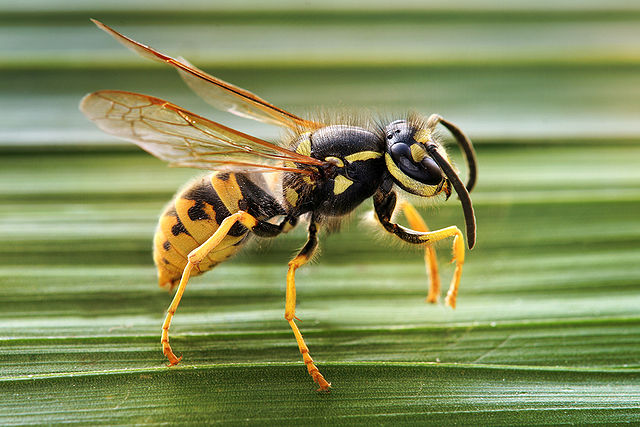The Oriental hornet is a social insect species of the family Vespidae. It can be found in Southwest Asia, Northeast Africa, the island of Madagascar, the Middle East, Central Asia, and parts of Southern Europe. Oriental hornets have also been found in a few isolated locations such as Mexico and Chile due to human introduction. The Oriental hornet lives in seasonal colonies consisting of caste system dominated by a queen. The hornet builds its nests underground and communicates using sound vibrations. The hornet has a yellow stripe on its cuticle (exoskeleton), which can absorb sunlight to generate a small electrical potential, and this might help supply energy for digging. The adult hornet eats nectar and fruits and scavenges for insects and animal proteins to feed to its young. Because they are scavengers, the hornets may also serve as a transmitter of disease following consumption of infected plants. The hornets are a primary pest to honey bees, attacking bee colonies to obtain honey and animal proteins. The sting of an Oriental hornet can be quite painful to humans and some humans are allergic to stings.

Oriental hornet
Workers at the nest entrance are fanning their wings to cool down the nest on a hot midday.
Face of an Oriental hornet, photo taken in Masada National Park, Israel
The Vespidae are a large, diverse, cosmopolitan family of wasps, including nearly all the known eusocial wasps and many solitary wasps. Each social wasp colony includes a queen and a number of female workers with varying degrees of sterility relative to the queen. In temperate social species, colonies usually last only one year, dying at the onset of winter. New queens and males (drones) are produced towards the end of the summer, and after mating, the queens hibernate over winter in cracks or other sheltered locations. The nests of most species are constructed out of mud, but polistines and vespines use plant fibers, chewed to form a sort of paper. Many species are pollen vectors contributing to the pollination of several plants, being potential or even effective pollinators, while others are notable predators of pest insect species, and a few species are invasive pests.
Vespidae
Palaeovespa florissantia, late Eocene
German wasp
Median wasp nest







